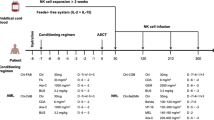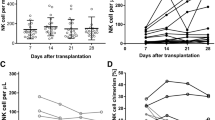Summary
The efficiency of dendritic cell-activated and cytokine-induced killer cell (DC-CIK) therapy on children with acute myeloid leukemia (AML) after chemotherapy was investigated. Mononuclear cells were collected from children achieving complete remission after chemotherapy, cultured in vitro and transfused back into the same patient. Interleukin-2 (IL-2) was injected subcutaneously every other day 10 times at the dose of 1×106 units. Peripheral blood lymphocyte subsets and minimal residual disease (MRD) were detected by flow cytometry. Function of bone marrow was monitored by methods of morphology, immunology, cytogenetics and molecular biology. The side effects were also observed during the treatment. The average follow-up period for all the 22 patients was 71 months and relapse occurred in two AML patients (9.1%). The percentage of CD3+/CD8+ cells in peripheral blood of 15 patients at the 3rd month after DC-CIK treatment (36.73%±12.51%) was dramatically higher than that before treatment (29.20%±8.34%, P<0.05). The MRD rate was >0.1% in 5 patients before the treatment, and became lower than 0.1% 3 months after the treatment. During the transfusion of DC-CIK, side effects including fever, chills and hives appeared in 7 out of 22 (31.82%) cases but disappeared quickly after symptomatic treatments. There were no changes in electrocardiography and liver-renal functions after the treatment. MRD in children with AML can be eliminated by DC-CIK therapy which is safe and has fewer side effects.
Similar content being viewed by others
References
Rubnitz JE, Gibson B, Smith FO. Acute myeloid leukemia. Hematol Oncol Clin North Am, 2010,24(1):35–63
Rubnitz JE, Inaba H, Dahl D, et al. Minimal residual disease-directed therapy for childhood acute myeloid leukaemia: results of the AML02 multicentre trial. Lancet Oncol, 2010,11(6):543–552
Sievers EL, Radich JP. Detection of minimal residual disease in acute leukemia. Curr Opin Hematol, 2000,7(4):212–216
Campana D. Progress of minimal residual disease studies in childhood acute leukemia. Curr Hematol Malig Rep, 2010,5(3):169–176
Jorgensen JL, Chen SS. Monitoring of minimal residual disease in acute myeloid leukemia: methods and best applications. Clin Lymphoma Myeloma Leuk, 2011,11(Suppl 11):49–53
Shook D, Coustan-Smith E, Ribeiro RC, et al. Minimal residual disease quantitation in acute myeloid leukemia. Clin Lymphoma Myeloma, 2009,9(Suppl 3):281–285
Wayne AS, Baird K. Egeler RM. Hematopoietic stem cell transplantation for leukemia. Pediatr Clin North Am, 2010,57(1):1–25
Marten A, Renoth S, Lilienfeld-Toal M, et al. Enhanced lytic activity of cytokine-induced killer cells against multiple myeloma cells after co-culture with idiotype-pulsed dendritic cells. Haematologica, 2001,86(10):1029–1037
Linn YC, Hui KM. Cytokine-induced killer cells: NK-like T cells with cytotolytic specificity against leukemia. Leuk Lymphoma, 2003,44(9):1457–1462
Wang QJ, Wang H, Pan K, et al. Comparative study on anti-tumor immune response of autologous cytokine-induced killer (CIK) cells, dendritic cells-CIK (DC-CIK), and semi-allogeneic DC-CIK. Chin J Cancer, 2010,29(7):641–648
Zhong R, Teng J, Han B, et al. Dendritic cells combining with cytokine-induced killer cells synergize chemotherapy in patients with late-stage non-small cell lung cancer. Cancer Immunol Immunother, 2011,60(10):1497–1502
Tan G, Zhang X, Feng H, et al. The therapeutic effect of cytokine-induced killer cells on pancreatic cancer enhanced by dendritic cells pulsed with K-ras mutant peptide. Clin Dev Immunol, 2011:649359
Wei XC, Zhai XH, Han XR, et al. Influence of dendritic cells on biological activity of the homologous CIK cells and its anti-leukemia effect in vitro. Zhong Guo Shi Yan Xue Ye Xue Za Zhi (Chinese), 2010,18(4):946–951
Li J, Gu LJ, Xue HL, et al. Response rate of AML-XH-99 protocol in the treatment of 82 childhood acute myeloid leukemia. Zhonghua Xue Ye Xue Za Zhi (Chinese), 2004,25(6):351–354
Leymarie V, Galoisy AC, Falkenrodt A, et al. Diagnosis of myeloid hematologic malignancies: contributions of the 2001 World Health Organization (WHO) classification. Ann Biol Clin (Paris), 2004,62(5):513–520
Saglio G. Minimal residual disease detection in human leukemias: biologic and clinical significance. Acta Haematol Pol, 1995,26(2Suppl 1):19–24
Su X, Zhang L, Jin L, et al. Coculturing dendritic cells with zoledronate acid efficiently enhance the anti-tumor effects of cytokine-induced killer cells. J Clin Immunol, 2010,30 (5):766–774
van den Ancker W, van Luijn MM, Westers TM, et al. Recent advances in antigen-loaded dendritic cell-based strategies for treatment of minimal residual disease in acute myeloid leukemia. Immunotherapy, 2010,2(1):69–83
Takei F. LAK cell therapy of AML: not to be lost in translation. Exp Hematol, 2011,39(11):1045–1046
Suck G. Novel approaches using natural killer cells in cancer therapy. Semin Cancer Biol, 2006,16(5):412–418
Vauleon E, Avril T, Collet B, et al. Overview of cellular immunotherapy for patients with glioblastoma. Clin Dev Immunol, 2010;2010. pii: 689171. [Epub 2010 Oct 4] doi: 10.1155/2010/689171
Kadowaki N. Dendritic cells: a conductor of T cell differentiation. Allergol Int, 2007,56(3):193–199
Seo MJ, Kim GR, Son YM, et al. Interactions of dendritic cells with cancer cells and modulation of surface molecules affect functional properties of CD8+ T cells. Mol Immunol, 2011,48(15–16):1744–1752
Chen ZC, Li JY, Yao JX, et al. Dendriticcell-activated and cytokine-induced killer cells therapy for the treatment of acute mylocytic leukemia previously given auto-PBSCT. Linchuang Neike Zazhi (Chinese), 2007,24(9):596–598
Author information
Authors and Affiliations
Corresponding author
Additional information
The first two authors contributed equally to this manuscript.
This project was supported by grants from the National Natural Science Foundation of China (No. 81000211) and Important Research Project from Health Department of Hubei Province, China (No. JX4A05).
Rights and permissions
About this article
Cite this article
Bai, Y., Zheng, Je., Wang, N. et al. Effects of dendritic cell-activated and cytokine-induced killer cell therapy on 22 children with acute myeloid leukemia after chemotherapy. J. Huazhong Univ. Sci. Technol. [Med. Sci.] 35, 689–693 (2015). https://doi.org/10.1007/s11596-015-1491-5
Received:
Revised:
Published:
Issue Date:
DOI: https://doi.org/10.1007/s11596-015-1491-5




